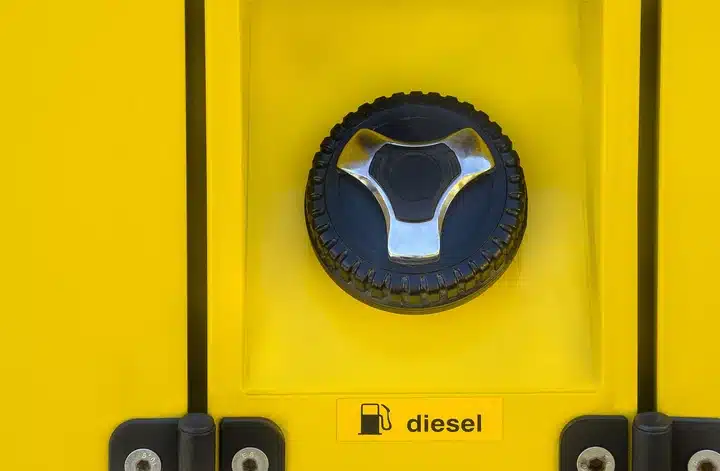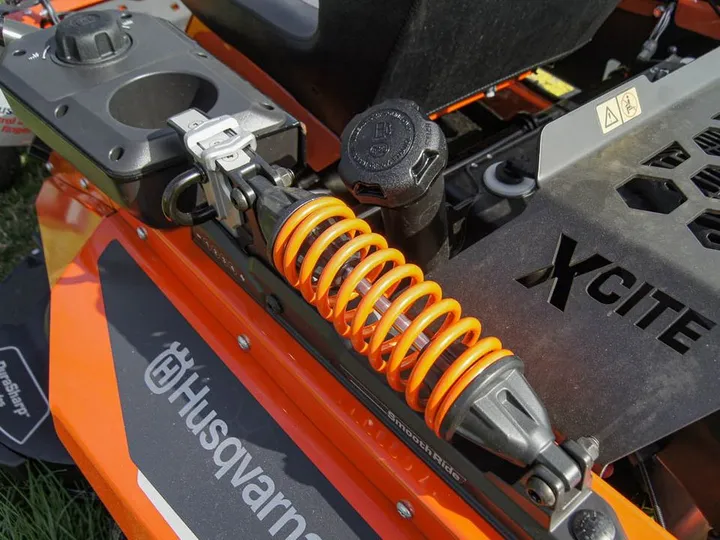Draining gas from a lawn mower can be as necessary as changing the oil in your car, yet many people overlook this crucial maintenance step.
As someone who’s spent years tinkering with and maintaining outdoor equipment, I’ve come to appreciate the subtleties of this task.
It’s not just about keeping your machine running smoothly—it’s also about safety and longevity. Whether you’re winterizing your mower or simply replacing old fuel, the process can seem daunting at first.
But don’t worry, I’m here to guide you through each method, from using a siphon pump to manual tilting techniques.
Quick Summary
- Draining gas from a lawn mower involves using a siphon pump or manually tilting the mower to remove old or contaminated fuel, ensuring the machine’s smooth operation and safety.
- Employing safety measures such as unplugging the spark plug wire and using protective gear is crucial during the gas draining process.
- Approximately 75% of lawn mower issues are attributed to old or bad gas, highlighting the importance of regular fuel maintenance.
- Personally, I find that taking the time to properly drain and maintain my lawn mower’s fuel system not only enhances its performance but also gives me peace of mind knowing it’s ready for use.
Step By Step: How to Drain Gas from a Lawn Mower
- Unplug the Spark Plug Wire
- Gather Supplies
- Access the Lawn Mower’s Gas Tank
- Drain the Gas Using Siphon Pump
- Empty the Gas Tank
- Reconnect the Spark Plug Wire
- How To Drain Gas from a Lawn Mower Without a Siphon Pump
- Manual Tilting
- Using a Funnel
- Disconnecting Fuel Line
How To Drain Gas from a Lawn Mower with a Siphon Pump
First, I make sure to unplug the spark plug wire for safety; it’s a crucial step before I start handling the fuel.
I then gather all the necessary supplies, including a siphon pump, to efficiently drain the gas from the lawn mower’s tank.
With everything ready, I access the gas tank and use the siphon pump to carefully remove the gasoline, ensuring the tank is completely empty.
Unplug the Spark Plug Wire
Before using a siphon pump to drain the gasoline, I ensure the lawn mower’s engine is off by disconnecting the spark plug wire.
This crucial step is one of the safety precautions that can’t be overlooked. It helps prevent any accidental ignition risks while I’m handling the fuel.
Spark maintenance is also essential for engine health, and disconnecting the wire gives me a chance to inspect it for wear or damage. If I find any issues, I can address them before they lead to bigger problems.
Gather Supplies
To successfully siphon the gas out of my lawn mower, I’ll need a few key supplies, including a siphon pump, a fuel container, and gloves for safety. As I prepare for this task, I’m mindful of the environmental concerns associated with fuel disposal.
I’ve chosen a container that’s specifically designed for gasoline to ensure it’s safely stored and won’t leak. I’m taking all necessary safety precautions, like wearing gloves to protect my hands from the fuel.
Access the Lawn Mower’s Gas Tank
Adhering to safety precautions, I ensure the mower is off and cool to the touch to prevent any accidents.
I proceed with gas cap removal, unscrewing it gently to avoid damaging the threads. With the cap off, I check the fuel for stability; if it’s degraded or contaminated, it’s essential to dispose of it properly.
Drain the Gas Using Siphon Pump
I place the siphon pump’s tube into the gas tank, ensuring it reaches the bottom to effectively remove all the fuel. Adhering to safety precautions, I wear gloves and goggles to protect myself from accidental spills.
Starting the pump, the gas flows out smoothly, and I’m careful to direct it into an approved container for proper gas disposal. It’s crucial to dispose of old fuel responsibly, following local regulations.
Afterward, I take a moment to jot down storage tips for my notes, like adding fuel stabilizers before long-term storage. This practice is vital for seasonal maintenance, ensuring my lawn mower starts up without a hitch next spring.
By doing this, I prevent fuel degradation and save myself future hassles.
Empty the Gas Tank

With the safety measures in place and the siphon pump ready, it’s time to empty the gas tank of the lawn mower.
I’m all about doing things right, so I’ve taken the necessary safety precautions to prevent spills and fumes from causing trouble.
I’m mindful of environmental concerns, too; I know that improper fuel disposal is a no-go.
By using a siphon pump, I can transfer the gas into an appropriate container.
If I’m prepping for seasonal storage, I’ll make sure to use a fuel stabilizer beforehand. It’ll keep the gas in good condition, ready for when I need to use the mower again.
Draining the tank isn’t just a chore—it’s a step to ensure my mower’s longevity and protect the environment.
Related: Gas to Use in Bad Boy Mower: All You Need to Know
Reconnect the Spark Plug Wire
I carefully attach the wire back onto the spark plug, a crucial step in spark plug maintenance. This simple action is a safeguard against ignition safety issues, preventing accidental starts while I’m working on the mower.
With the spark plug connected, I also avoid the risk of engine flooding, which can occur if the engine turns over without proper fuel.
Before I consider the job done, I give the mower a quick check to ensure proper storage. I’ll remember to add a fuel stabilizer next time I fill up, to maintain the engine’s health and guarantee a smooth start when it’s time to mow again.
How To Drain Gas from a Lawn Mower Without a Siphon Pump
Let’s say you don’t have a siphon pump handy—I’ve been there! I’ll show you how to carefully tilt the mower to drain the gas into an appropriate container.
We can also discuss how to safely disconnect the fuel line for a more thorough job.
Manual Tilting
To drain gasoline from a lawn mower without the aid of a siphon pump, you can manually tilt the machine, carefully directing the fuel into an appropriate container. It’s crucial to consider tilt safety to avoid accidents.
Before I tilt the mower, I make sure it’s stabilized to prevent it from slipping or falling. I’m mindful of selecting a flat, hard surface to ensure stability.
One thing I watch out for is oil leakage, which can happen if the mower isn’t tilted correctly. I also take into account environmental concerns, making sure not to spill any gasoline on the ground.
Draining fuel this way requires caution, but it’s doable with the right precautions.
Using a Funnel
Employing a funnel is another effective method to drain gasoline from a lawn mower without using a siphon pump, ensuring a clean and directed flow into a suitable receptacle.
I always prioritize safety gear, like gloves and goggles, to protect myself from accidental spills and fumes.
Considering environment considerations, I make sure to drain the fuel into a container approved for fuel disposal. This prevents any hazardous leaks into the ground.
I’ve found that having a few dedicated storage options for old gas is helpful, especially containers that seal tightly to prevent evaporation or spillage.
Remembering to perform this maintenance frequently, especially before long-term storage, keeps my lawn mower in top shape and reduces the risk of fuel degradation over time.
Disconnecting Fuel Line
Disconnecting the fuel line, a crucial step in draining gasoline, requires careful handling to prevent fuel spillage and potential hazards. I always prioritize fuel safety, knowing that even a small mistake can lead to big problems.
Before I begin, I make sure the engine is cool to avoid any risk of combustion. This is part of my engine prep routine.
Next, I carefully inspect the hose for any signs of wear or damage, as line maintenance is key to avoiding leaks. I then choose the right clamp types to secure the hose. Using either spring clamps or screw clamps, I gently disconnect the fuel line.
I’m always prepared for a little gas to spill out, so I’ve rags at hand and work in a well-ventilated area.
Additional Information: Gasoline Handling and Lawn Mower Maintenance

Promoting environmental responsibility, enhancing safety measures, and providing effective troubleshooting techniques to ensure your lawn mower runs efficiently and safely.
Responsible Disposal and Environmental Considerations
Understanding the environmental implications of gasoline disposal is critical. Incorrect disposal can lead to severe environmental damage, including groundwater contamination.
It’s important to familiarize yourself with local hazardous waste regulations to ensure responsible disposal.
Enhanced Health and Safety Measures
While draining gasoline, comprehensive safety measures go beyond gloves and goggles. Adequate ventilation is key to avoid inhaling toxic fumes. Keeping a fire extinguisher close due to the high flammability of gasoline is also crucial.
In case of accidental exposure, immediate first aid steps should be taken, such as rinsing any skin contact with soap and water and seeking medical attention for more severe exposures.
Troubleshooting Post-Drainage Complications
Encountering operational issues after draining gas from a lawn mower is not uncommon. A troubleshooting guide can be invaluable, including checks for gas remnants, clear fuel lines, and functional spark plugs.
Post-Storage Lawn Mower Maintenance
After a mower has been stored for an extended period, particularly over winter, it requires thorough maintenance. This includes inspecting for rust or damage, checking tire pressure, lubricating parts, and ensuring a charged battery for electric models.
Alternative Uses for Drained Gasoline
Exploring possible uses for the drained gasoline, such as for parts cleaning or as a solvent, adds an interesting perspective. However, it’s important to emphasize the risks involved and the necessity of understanding the chemical properties of gasoline.
Our Verdict
I’ve realized that draining gas from a lawn mower, while often overlooked, is a fundamental aspect of ensuring the longevity and efficiency of your machine.
Whether I’m using a siphon pump for a clean and quick job or opting for the manual tilt method in its absence, the process has always been more straightforward than it might seem.
The key is to approach it with care and understanding – recognizing the importance of safety measures and the environmental implications of gasoline handling.
This routine maintenance not only keeps my mower in top condition but also offers me peace of mind, knowing that when the grass starts growing again, my mower will be ready without fail.
It’s a simple yet essential task that, in my experience, makes a significant difference in the performance and reliability of your lawn care equipment.
Frequently Asked Questions
Can old gas be reconditioned for use after being drained from a lawn mower, or should it always be disposed of?
I’ve heard that gas reconditioning might work using fuel stabilizers to counteract ethanol effects and restore the octane rating, but it’s risky. I’d say it’s safer to just use fresh gas with proper chemical additives.
Is there a risk of damaging the lawn mower’s engine if the gas is not completely drained before storage?
I’m concerned about engine corrosion and fuel stability if I don’t drain the gas before long-term storage. Maintenance frequency and ethanol effects could also worsen if I’m not thorough.
How can I tell if my lawn mower’s fuel has gone bad before attempting to drain it?
I’ll sniff for unusual fuel smell, check for color change, and note any engine sputtering. Starting issues or a performance decline also clue me in that my mower’s fuel might have degraded.
Are there any environmental regulations I should be aware of when disposing of gasoline from my lawn mower?
I’m checking local ordinances for gasoline recycling to minimize environmental impact. I’ll ensure I’m compliant with hazardous waste regulations and will use designated disposal sites for safe handling of the fuel.
What safety precautions should I take to prevent fire or injury when draining gas from my lawn mower?
I always ensure proper fuel containment, avoid sparks, wear protective gear, work in a well-ventilated area, and keep a fire extinguisher handy to prevent fire or injury during such maintenance tasks.


